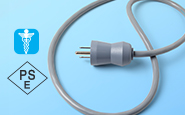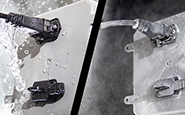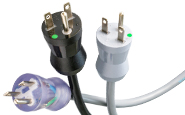More Information on Power Entry Modules
Looking for Hospital-Grade Information? Click here
When properly specified for a particular application, Interpower power entry modules offer one or more of the following benefits:
Increase User Safety
The risk of accidents is reduced when using a power entry module. The design of most modules makes it necessary to remove the power cord assembly from the unit prior to making any changes like fuse replacement and/or voltage selection. Interlocking the power entry connector with access to other module functions reduces the probability of accidental shock by the user.
Save Panel Space
Power entry modules combine several power entry components into one panel mounting system, saving panel space. Interpower modules are smaller than most. This reduces the mounting hole size, thus saving valuable space on the mounting surface (Figure 1).
Reduce Assembly Labor
Power entry modules can reduce installation labor costs. The combination of several components into one package reduces the number of components that must be handled. Assembly labor costs may be reduced through the internal connections that are a part of some modules.
Lower Component Management and Costs
While modules rarely save money when compared to direct material cost, the savings in assembly, engineering, and materials handling time may more then cover the additional costs. Reducing the number of components used in equipment avoids a waste of valuable engineering time through reduction in testing and documentation recording for component and agency approvals. Materials, handling, and purchasing time are also reduced through reduction in inventory.
Quality
100% Interpower modules are tested. These tests include dielectric strength and continuity. This assures the modules will work in applications for which they were designed.
Approvals
All Interpower power entry modules meet the requirements of the UL, CSA, and VDE approval agencies. This shortens the process of acquiring approvals on equipment. Additional testing of components is unnecessary when approved components are used. Specifying modules with UL, CSA, and VDE approvals allows only one component to be ordered and stocked when manufacturing equipment for international and North American applications.
Specifying a Module
When selecting a module, functions and mounting orientation need to be addressed. Power entry modules are available with a variety of component combinations and two mounting styles. The components are listed below with a brief description of the functions that will impact the specification decision (Figure 2).
AC Power Inlet
The modules direct power into the equipment using an IEC 60320 C14 power inlet. The C14 is a Class I grounded connection device and is used with the IEC 60320 C13 connector. The C13 connector is accepted internationally, making it easy to select the correct cordset from Interpower Corporation. Current ratings for the C14 power inlet are normally 10A for international applications.
Power Switch
The power switch keeps the power control near the source of power on the equipment. All switches used in the modules are double-pole, single-throw switches, making them ideal for use in medical applications around the world. The switch controls both the line and neutral conductors. Module power switches are normally rated at 4–10A at 250VAC. The availability of vertically or horizontally marked switches makes it possible to meet IEC standards for correct marking alignment on switches.
Fuse Holder
Interpower power entry modules can be used with either 1⁄4 x 11⁄4" or 5 x 20mm fuses. They are available in single or double fused versions. The design of the Interpower power entry module allows you to quickly change a single-fused module to double-fused by simply removing the fuse substitution clip. In a single fused module, the clip must be positioned on the neutral side of the circuit for the module to work (Figure 3).
Voltage Selector
Voltage selection allows equipment to be designed and manufactured to operate on approximately 115 or 230VAC. By changing the selection device, this allows the user to define the correct input voltage. Voltage selection changes are made by removing the fuse holder and rotating it (Figure 4).
Filtering
Filters play an important part in equipment design, especially in high frequency and medical equipment applications. Interpower filtered power entry modules are available with or without a metal shield, typically specified in high frequency applications.• RFI/EMI filtersAn RFI/EMI filter is an electrical circuit that is designed to remove electromagnetic and radio frequency interference (noise) from the equipment. This prevents malfunctions due to interference and also prevents the equipment from radiating noise, which might interfere with other equipment.The typical frequency filtered is 10,000Hz to 30,000,000Hz for noise picked up and conducted through external wires or power cords. The frequency filtered for noise that is radiating and being picked up through the air is 30,000,000Hz to 1GHz.• Insertion LossInsertion loss is the value (in dB) determined from a ratio of the voltage passed through the equipment without filtering, versus the voltage passed through the equipment with filtering. Common mode insertion loss is used to express the amount of signal lost on both the line and neutral conductors (when referenced to ground), due to removal of interference or noise by the filter circuit. Differential mode insertion loss is used to express the amount of signal lost on either the line or neutral conductors (when referenced to the other, i.e. between line and neutral), due to removal of interference or noise by the filter circuit. Insertion loss values are typically based on the results of a 50ohm test circuit. Interpower Corporation recommends customers obtain samples and conduct testing to evaluate actual filter performance in their application.
Medical Power Entry Modules
Medical equipment must meet special requirements. These requirements place special significance on fusing and filtering when selecting components used in medical equipment. Patient-connected medical equipment can be subjected to low-leakage current requirements. The use of a low-leakage filter in the 5µA range at 250VAC is desirable. In addition, fusing of both line and neutral connectors may be required (i.e. double fusing).
Mounting
The Interpower power entry modules are available in both snap-in and screw mount versions to meet design requirements. Space limitations are an important reason for using power entry modules.





